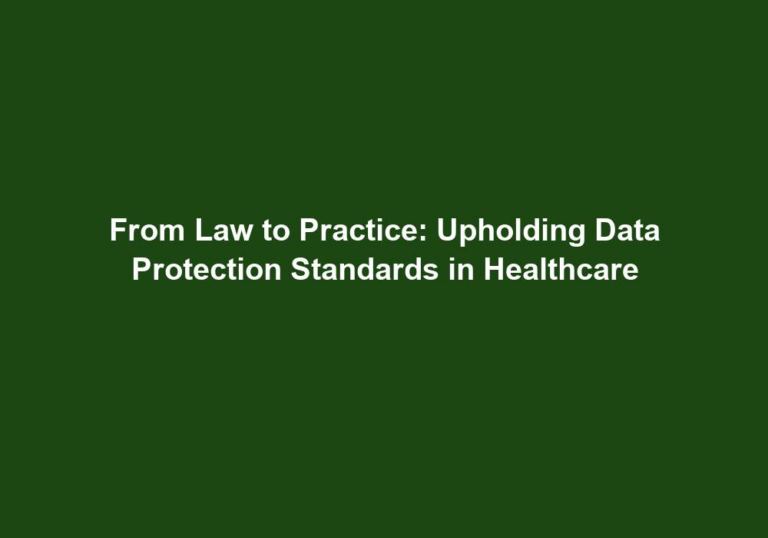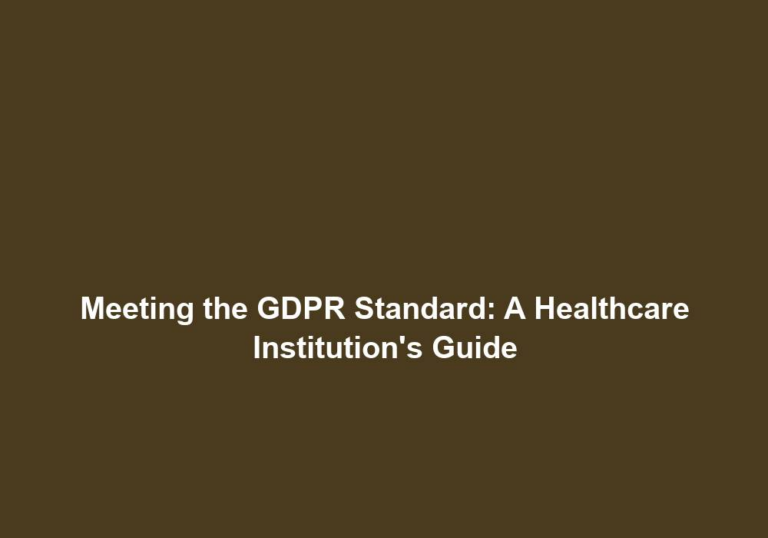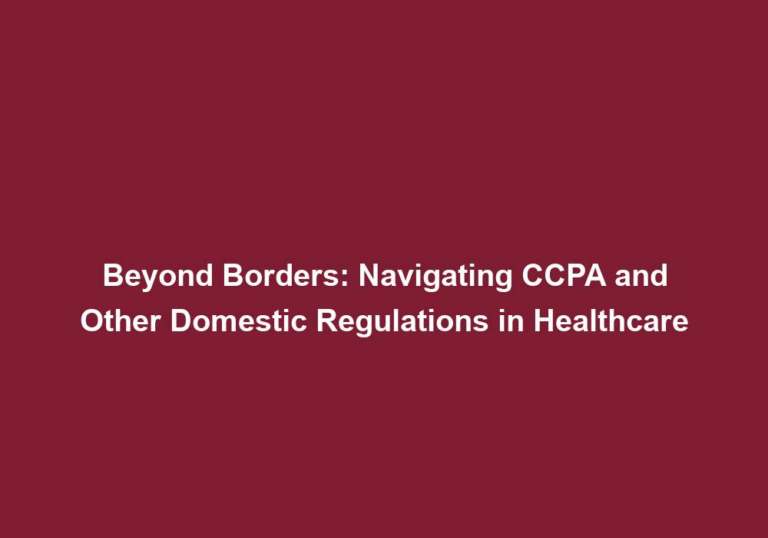The European Touch: Adapting to GDPR in Global Healthcare Settings
In recent years, the General Data Protection Regulation (GDPR) has emerged as a critical framework for data protection and privacy in the European Union (EU). This regulatory initiative has significant implications for global healthcare settings, as it requires organizations to implement robust measures to safeguard personal data of EU citizens. In this article, we will explore the key aspects of GDPR and discuss how healthcare providers and organizations worldwide can adapt to comply with these regulations.
Understanding GDPR: A Brief Overview
GDPR is a comprehensive data protection regulation that came into effect on May 25, 2018. Its primary objective is to enhance the rights and privacy of individuals within the EU while creating a consistent framework for data protection across member states. GDPR applies not only to organizations located within the EU but also to those outside the EU that process personal data of EU citizens.
GDPR introduces several key principles that organizations must adhere to in order to comply with the regulation. These principles are designed to ensure lawful and fair processing, transparency and accountability, data minimization, security and confidentiality, and the protection of data subject rights.
Key Principles of GDPR
To effectively adapt to GDPR in global healthcare settings, it is crucial to comprehend the key principles that underpin this regulation:
Lawful and Fair Processing
GDPR mandates that all personal data collected and processed must have a lawful basis for processing. Healthcare providers must establish a legal justification for obtaining and using personal data, such as the necessity for medical treatment or fulfilling contractual obligations. It is essential to inform individuals about how their data will be processed and obtain their explicit consent.
Healthcare organizations should also ensure that there is a fair and transparent process in place for individuals to exercise their rights regarding their personal data. This includes providing individuals with clear and easily understandable information about data processing, including the purpose, lawful basis, retention period, and their rights as data subjects.
Transparency and Accountability
Transparency is a cornerstone of GDPR. Healthcare organizations must provide individuals with clear and easily understandable information about data processing. This includes details about the purpose, lawful basis, retention period, and rights of the individuals. Organizations must also maintain records of processing activities and implement appropriate security measures to protect personal data.
Accountability is another key aspect of GDPR. Organizations must be able to demonstrate compliance with the regulation by implementing measures such as privacy policies, data protection impact assessments, and appointing a Data Protection Officer (DPO). These measures ensure that organizations take responsibility for the processing of personal data and can be held accountable for any breaches or non-compliance.
Data Minimization
Healthcare providers should only collect and process personal data that is necessary for the specific purpose it was obtained. Unnecessary data should be avoided to minimize the risk of data breaches and ensure compliance with GDPR. Regular data audits can help identify and eliminate any surplus or outdated information.
Data minimization not only helps organizations comply with GDPR but also enhances data security and privacy. By reducing the amount of personal data collected and processed, healthcare organizations can minimize the potential impact of a data breach and protect the privacy of individuals.
Security and Confidentiality
Under GDPR, healthcare organizations must implement technical and organizational measures to ensure the security and confidentiality of personal data. This includes measures such as encryption, access controls, regular system updates, and staff training to mitigate the risk of unauthorized access, disclosure, alteration, or destruction of personal data.
Maintaining the security and confidentiality of personal data is crucial to comply with GDPR and protect the privacy of individuals. Healthcare organizations should adopt industry-standard security measures and regularly review and update their security practices to address emerging threats and vulnerabilities.
Data Subject Rights
GDPR grants individuals several rights concerning their personal data. Healthcare providers must facilitate the exercise of these rights, which include the right to access, rectify, erase, restrict processing, data portability, and object to processing. Organizations must have mechanisms in place to handle such requests promptly and efficiently.
To comply with GDPR, healthcare organizations should establish processes and procedures to handle data subject rights requests. This includes providing individuals with a clear and accessible means to exercise their rights, responding to requests within the required timeframes, and ensuring that the necessary systems and resources are in place to facilitate the exercise of these rights.
Adapting to GDPR in Global Healthcare Settings
Complying with GDPR can be a complex process, especially for global healthcare organizations. Here are some key steps and considerations to help adapt to GDPR successfully:
Conduct a Data Inventory and Assessment
Start by conducting a comprehensive data inventory and assessment across all systems, applications, and processes that involve personal data. This exercise will help identify the types of personal data collected, the purposes for processing, and any data transfers to third parties. It is crucial to map the data flow within the organization to ensure compliance with GDPR.
During the data inventory and assessment process, healthcare organizations should document all personal data processing activities, including the legal basis for processing, the categories of personal data processed, and the recipients of the data. This information will help organizations identify any gaps in compliance and take necessary corrective actions.
Review and Update Privacy Policies and Consent Mechanisms
Review and update privacy policies to align with the transparency requirements of GDPR. Policies must clearly state the purposes for data processing, the legal basis, retention periods, and the rights of individuals. Consent mechanisms should be GDPR-compliant and provide individuals with a genuine choice regarding the use of their data.
Healthcare organizations should ensure that their privacy policies are easily accessible and written in clear and plain language. The policies should clearly explain how personal data is collected, processed, and stored, as well as the rights of individuals and the procedures for exercising those rights. Consent mechanisms should be opt-in, explicit, and granular, giving individuals the opportunity to provide specific consent for different processing activities.
Implement Robust Security Measures
Ensure that appropriate technical and organizational security measures are in place to protect personal data. This may include the use of encryption, access controls, firewalls, regular security updates, and employee training programs. Implementing a privacy by design approach can help embed data protection into the organization’s systems and processes from the outset.
Healthcare organizations should regularly assess and update their security measures to address emerging threats and vulnerabilities. This may involve conducting regular security audits, implementing intrusion detection systems, and providing ongoing training and awareness programs for employees. By prioritizing security and adopting a proactive approach, organizations can mitigate the risk of data breaches and ensure compliance with GDPR.
Establish Data Protection Impact Assessments (DPIAs)
DPIAs are an essential tool for assessing and mitigating privacy risks associated with data processing activities. Identify high-risk processing activities and conduct DPIAs to evaluate the impact on individuals’ privacy rights. DPIAs should be carried out before implementing new systems or processes and periodically reviewed to reflect any changes.
During the DPIA process, healthcare organizations should assess the potential risks and evaluate the measures in place to mitigate those risks. This includes identifying the purposes and legal basis for processing, assessing the necessity and proportionality of the processing, and considering any safeguards or measures to protect individuals’ rights. DPIAs should involve stakeholders from different departments to ensure a comprehensive assessment of privacy risks.
Appoint a Data Protection Officer (DPO)
Consider appointing a Data Protection Officer who will be responsible for ensuring compliance with GDPR. This role involves monitoring data protection practices, providing guidance, and acting as a point of contact for data subjects and supervisory authorities. The DPO should have expertise in data protection and be independent of any conflicts of interest.
The DPO plays a crucial role in ensuring that healthcare organizations comply with GDPR and protect the rights and privacy of individuals. In addition to monitoring compliance, the DPO should provide guidance on data protection matters, conduct internal audits, and act as a point of contact for individuals and supervisory authorities. The DPO should have a good understanding of the organization’s data processing activities and be able to provide timely and accurate advice.
Stay Up-to-Date with Regulatory Developments
GDPR is an evolving regulation, and it is crucial to stay informed about any updates or changes. Subscribe to relevant newsletters, attend conferences or webinars, and engage with industry associations or consultants to keep abreast of the latest regulatory developments. Regularly review and update policies and procedures to maintain compliance.
Healthcare organizations should establish a process to monitor and track regulatory developments related to GDPR. This may involve assigning responsibility to specific individuals or teams, conducting regular reviews of regulatory updates, and implementing procedures to assess the impact of any changes on the organization’s compliance efforts. By staying up-to-date with regulatory developments, healthcare organizations can proactively adapt to changes and ensure ongoing compliance with GDPR.
Conclusion
The GDPR has ushered in a new era of data protection and privacy in the global healthcare sector. Adapting to GDPR requires a comprehensive understanding of its principles and a proactive approach to compliance. By conducting thorough assessments, implementing robust security measures, and staying informed about regulatory developments, healthcare organizations can successfully navigate the European touch of GDPR in global healthcare settings.







